As a brand marketer, you invest the time, talent, and capital into creating great content that engages audiences and drives sales. However, without the right call-to-action (CTA) strategy, that content loses the ability to act as effectively as possible. An expertly crafted CTA reaches audiences when the likelihood of conversion is greatest and takes them further down the funnel.
A CTA encourages a prospect to take a specific action – like downloading a free resource or registering for an event – while they are engaged in your content. By strategically placing different types of CTAs in your content ecosystem and tailoring them to user intent, you can generate more leads and gradually turn new visitors into loyal customers.
This is how brand marketers are using CTAs today, along with the seven types of CTAs they use most often to drive important marketing results.
How brand marketers use CTAs
CTAs appear in content in different ways. For example, you can see them in-line in an article or be linked via anchor text at the end of a blog post. Graphical CTAs – like banners and buttons – can invite visitors to download free resources or sign up for demos.
In addition, there is a whole category of dynamic CTAs that you can use to control your audience. These include slide-in CTAs that can slide discreetly across the bottom of the screen to offer readers tips of direct interest, or pop-up CTAs that break up the experience with a bold offer for exclusive announcements or discounts.
CTAs in the sidebar can also appear directly to the right of a piece of content to make your presentation more reader-friendly and restrained. These are often preferred for newsletter registrations.
7 main types of CTAs
In addition to placement, it’s important to consider how CTAs enable your desired marketing outcomes, from event registration to social shares and beyond. Here are seven main types of CTAs and a breakdown of their use in your content ecosystem.
1. Read more / Learn more
A Read More / Read More CTA encourages your audience to delve into deeper funnel assets or solution pages. It works well in the awareness phase when an audience is looking for a solution to a problem or trying to understand an emerging trend that presents an opportunity for them. A Read More / Learn More CTA can find a natural home at the end of a blog post or article, as we see in this CTA from Verizon Business:
That’s why this Learn More CTA works:
- The CTA is located directly below the final paragraph of the article, making it a perfect point of contact for readers who want to learn more about the topic.
- It invites the reader to click through to the brand’s solution page.
- Having arrived at the solution page, the reader can move on to the consideration phase of the buyer journey.
2. Read related content
Brand marketers know they need to keep their audiences engaged, and sticky websites drive more conversions. A Read Related Content CTA is perfectly suited for this purpose, in order to conveniently draw the attention of interested parties to content that is directly relevant to a topic in which they have already shown interest. If the type of content they’re looking for is offered proactively, prospects are likely to spend more time on a website and move deeper into the awareness phase. Mendix gives readers the opportunity to delve further into the topic of legacy modernization here:
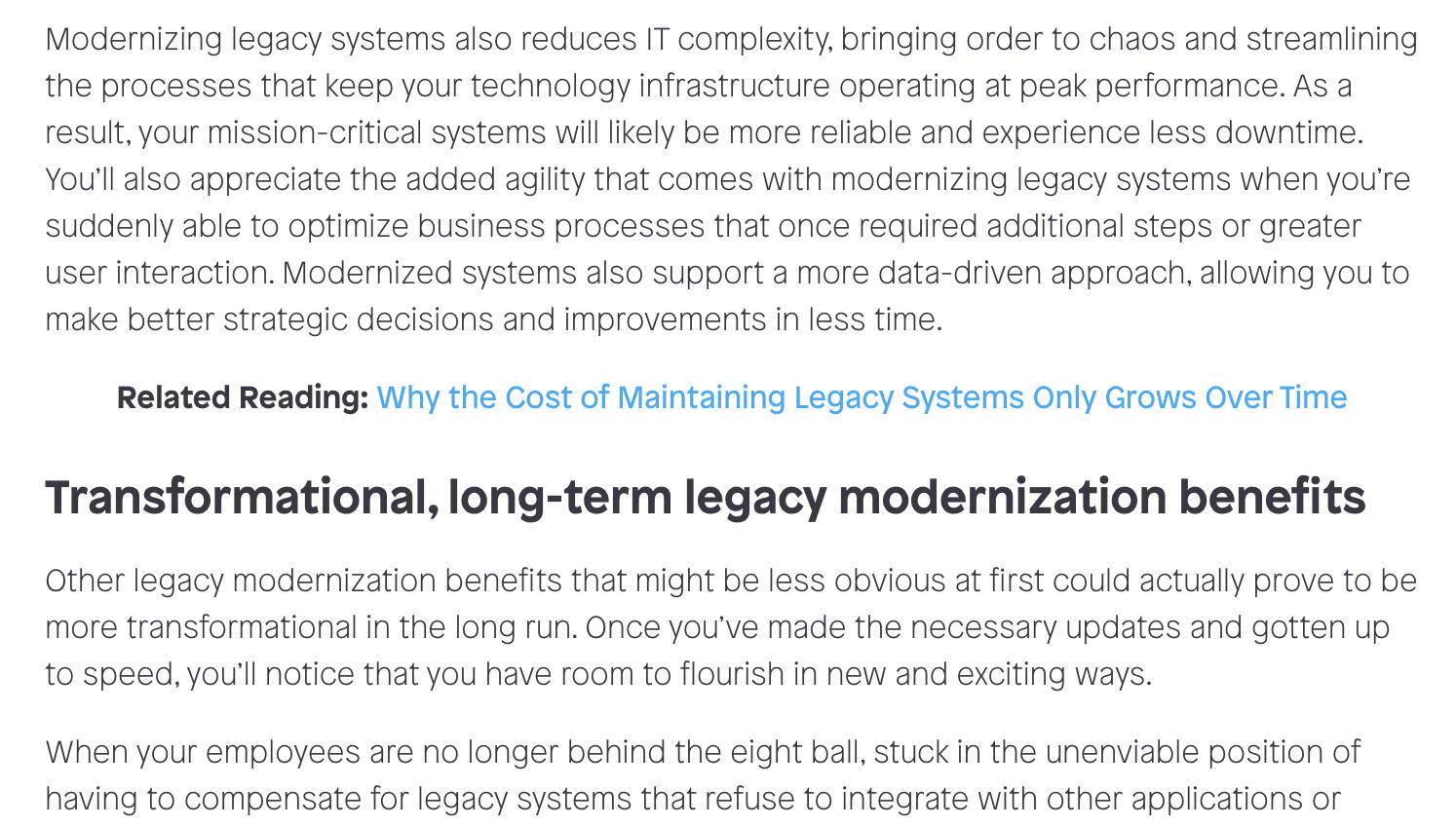 Here’s why this CTA works for reading related content:
Here’s why this CTA works for reading related content:
- This CTA is inserted in the body of the text, roughly in the middle of an article. If a prospect has read this far, they are likely interested in learning more about the subject.
- It provides the reader with closely related content that will help them gain a deeper understanding of the subject.
3. Social sharing
Brands that want to make a name for themselves on social media find social sharing CTAs particularly valuable. This type of CTA uses content to inspire new followers and expand the brand’s social reach. It works well for the awareness phase where the audience is just discovering the brand, or possibly even the market category itself. Tom’s of Maine publishes a short and crisp CTA at the end of this blog post on bath essential oils that signals readers to get involved with the brand on Twitter:
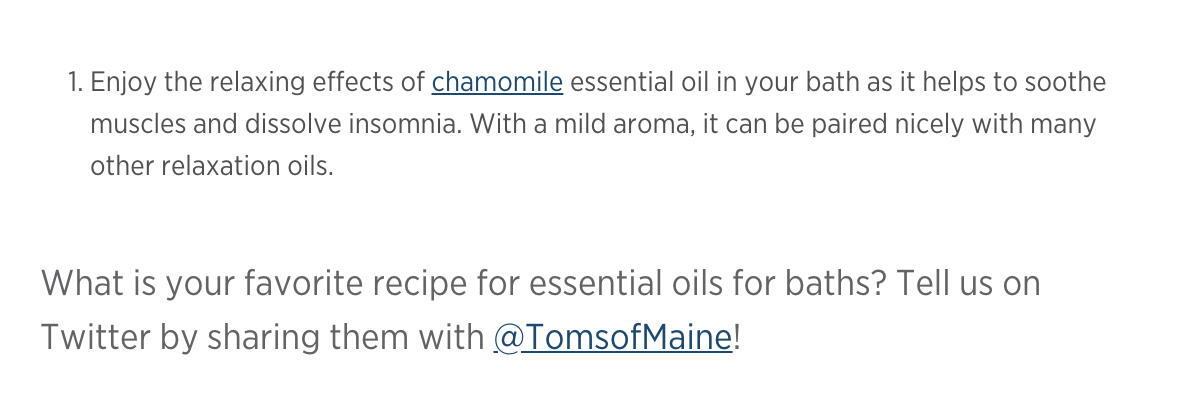
Here’s why this social sharing CTA works:
- This CTA invites readers to contribute their own original bath essential oil recipes and give them the opportunity to share their knowledge and recommendations.
- It also gives the audience an indication that this brand is active on social media and interested in talking to them.
4. Newsletter registration
A newsletter subscription CTA is perfect for capturing email leads. Brand marketers use this type of CTA to lead potential customers into a drip campaign and wow them with interesting and relevant messages that create awareness and attention while getting them deeper down the funnel. Here, Samsung Business Insights has a newsletter subscription CTA button in the lower left corner of the main content portal encouraging readers to get more content via email:
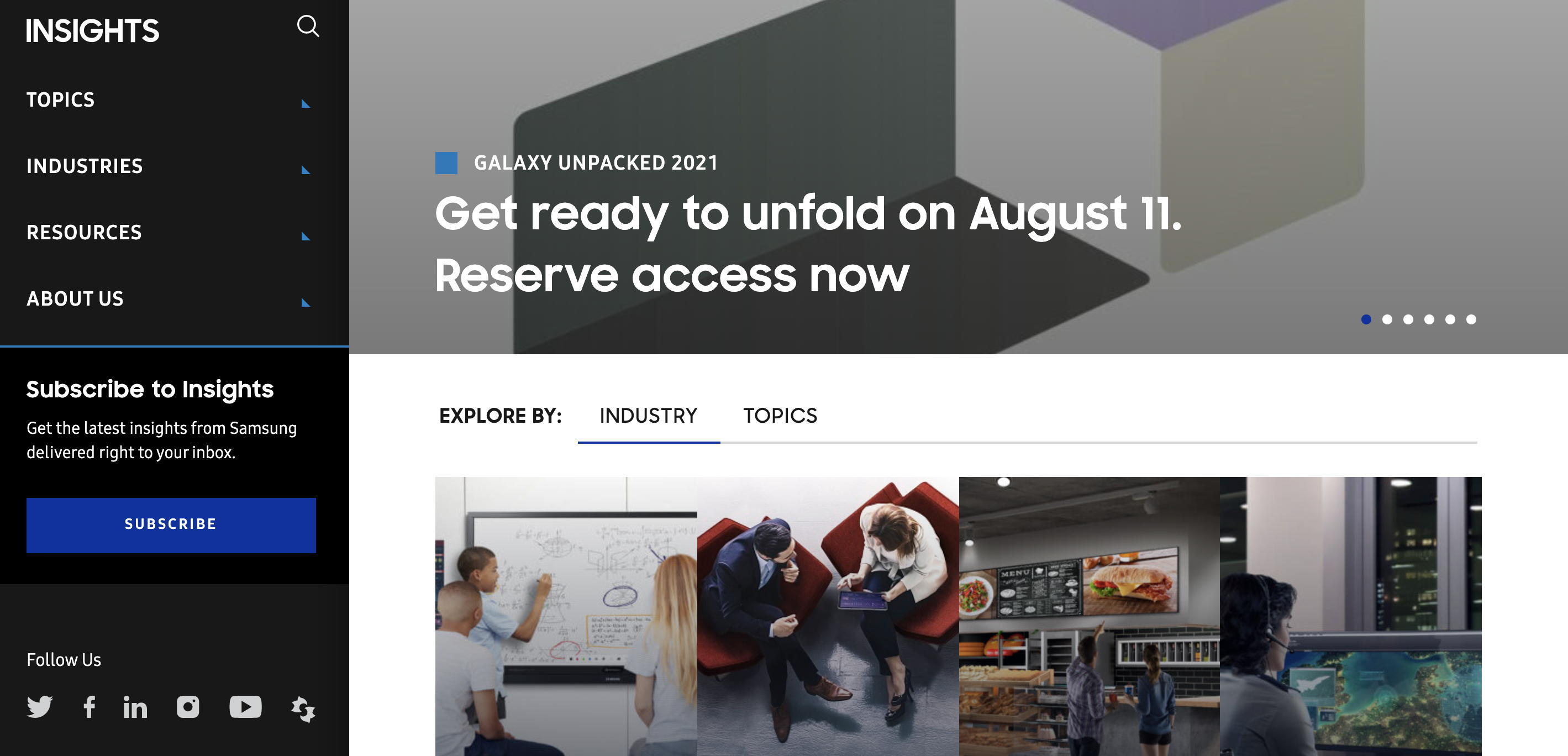
This is why this newsletter subscription works:
- This CTA – a light blue button in contrast to a black background on the main content portal – immediately catches the visitor’s eye.
- This CTA invites readers to get new content straight to their inbox instead of remembering to visit the website. Brands can also offer a newsletter subscription CTA like this one in a pop-up CTA that appears after a reader has consumed multiple pieces of content on the website.
5. Fill out the form to download
Audiences are often willing to share personal information when they believe they are receiving a valuable resource in return. When brand marketers combine compelling content with a fill out CTA to download, they are giving their audience a reason to share that data through a lead capture form. From there, they can either add this information to a drip campaign or share it with the sales team for follow-up.
As shown in this example, Vonage uses compelling content – an insightful report on video trends – to inspire its audience to fill out a form and download it right away.
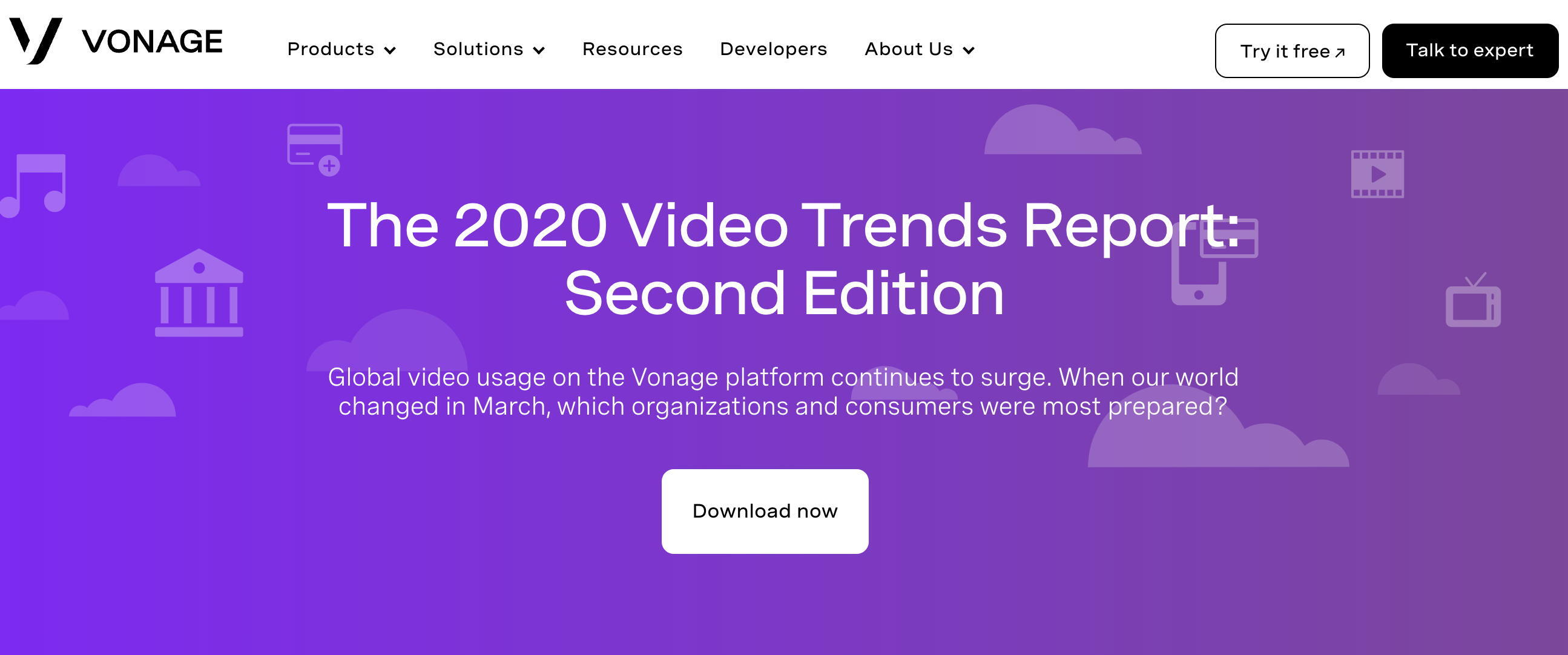
Here’s why this fill-out form works for the download CTA:
- This eye-catching CTA is prominently displayed with a wide banner graphic that contrasts the white button on a purple background.
- We are also given a brief description of the downloadable resource and the value it offers. This particular report contains current primary data.
- After clicking the “Download Now” button, the prospect will be asked to fill out a simple form that will help the brand properly qualify them.
6. Event registration
You can use an event registration CTA to collect lead data from a prospect. Once you’ve gathered this information, you can share it with your sales team and / or add it to a drip campaign if you wish. Depending on the event you’re promoting and the granularity with which a particular topic is explored, this type of CTA can either take your audience further into the awareness phase or take them into the reflection phase. At Skyword, we achieved this with a carefully placed CTA in an article on content audits, as you can see here:
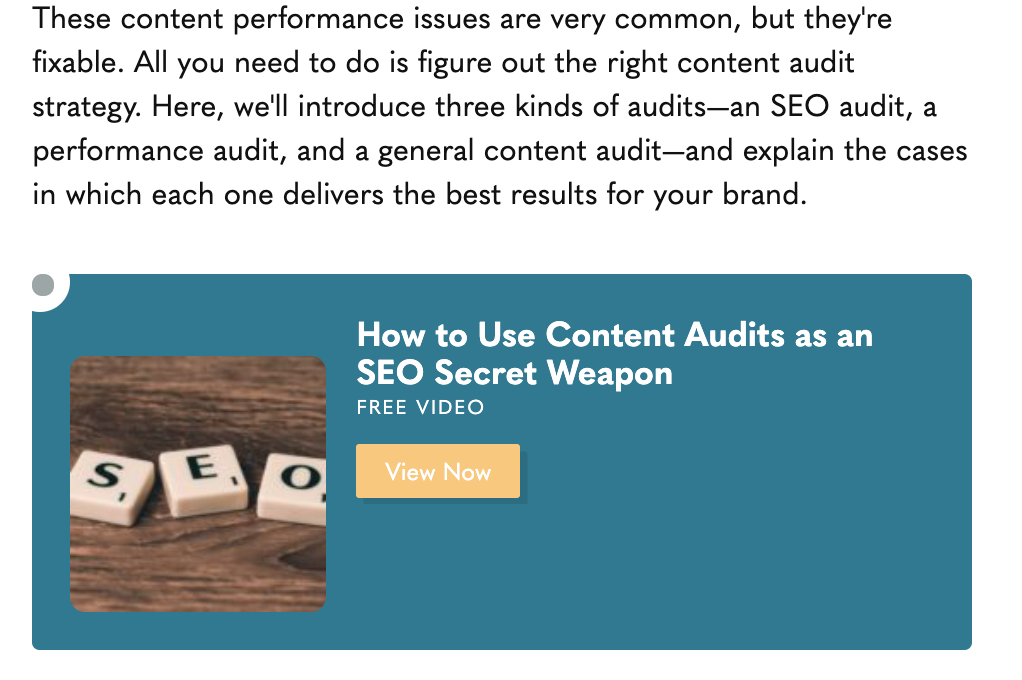
Here’s why this event registration CTA works:
- This CTA gives the audience the opportunity to explore the topic of the article more deeply with subject matter experts from the brand.
- It also gives them the opportunity to gain a deeper understanding of a complex topic in an accessible video format rather than having to read a long, complex white paper.
7. Demo / sales request
Offering a demo gives you the unique opportunity to capture lead data that can then trigger a sale. This CTA works well with audiences who have already spent some time in the awareness phase (an important requirement for many B2B tech audiences with complex needs, for example) and are ready to move into the consideration phase. Now they have a good sense of the problem or opportunity and are ready to take action via a product or service test.
As we can see in this example, Dynatrace includes a Demo Request CTA after an Event Registration CTA. This gives the audience multiple options to convert according to their preferences.

This is why this demo request CTA works:
- This CTA uses clean, attractive graphics that draw the reader’s attention to a compelling proposition.
- It provides a convenient way for the reader to explore the solution with a free hands-on trial.
Increase your marketing impact with these 7 essential CTAs
If you are consistently creating excellent content that resonates with your audience, the next logical step is to develop a closer relationship with them. And as brand marketers know, the only effective way to accomplish this is to give the audience an opportunity that fulfills a need or desire at the moment they are most interested in taking action. These seven CTAs help marketers make that connection, whether by inspiring audiences to engage with brands on social media or by downloading a resource they think is valuable. If marketers make sure to place the right CTAs across their entire content ecosystem, they can more effectively get their audience down the funnel and increase their marketing impact.
Subscribe to our monthly newsletter Content & Context to get new perspectives on the current marketing trends.
Attribution image attribution: Snapwire on Pexels
